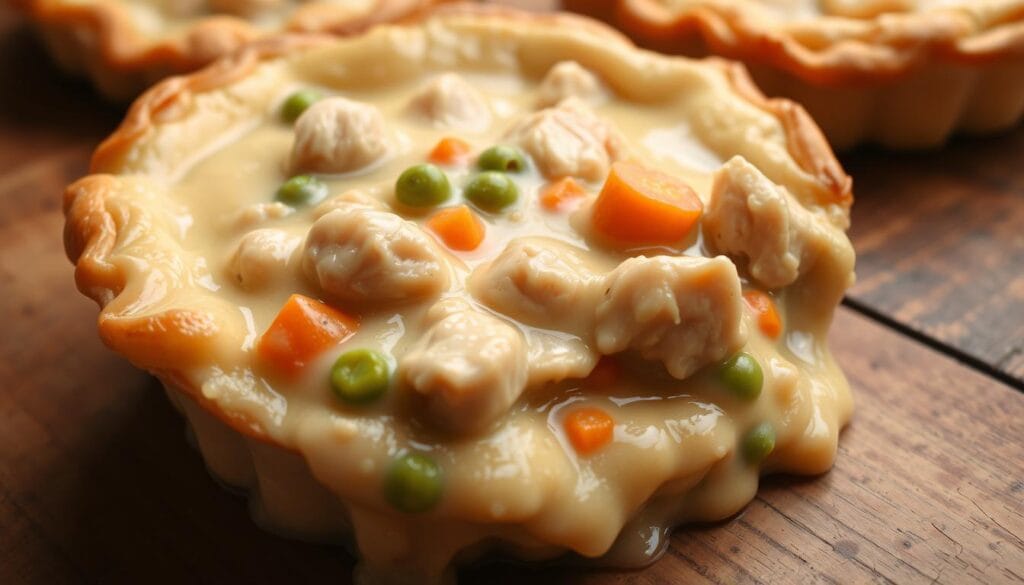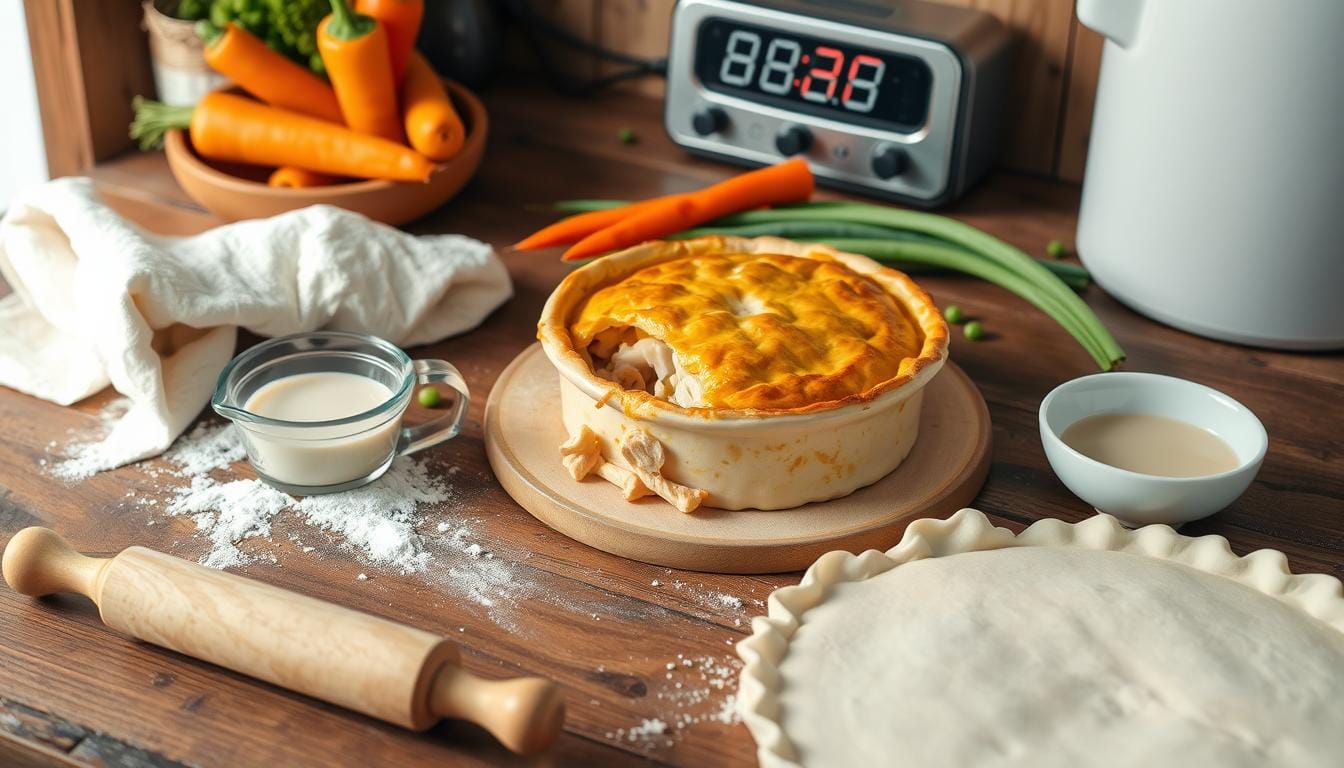There’s nothing worse than cutting into a chicken pot pie and finding it’s soupy. It’s a letdown, especially when you were hoping for a creamy filling. If you’ve struggled to fix this problem, you’re not alone.
Getting the perfect chicken pot pie consistency is an art. It’s all about precision and knowing the right techniques. Whether you’re cooking at home or aiming to be a pro chef, understanding why your pie is soupy can make all the difference.
Key Takeaways
- Understand the importance of proper vegetable preparation
- Learn critical techniques for thickening pie filling
- Recognize the role of temperature in pie consistency
- Master the balance between liquid and thickening agents
- Avoid common mistakes that lead to runny pot pie fillings
Table of Contents
Common Causes of a Soupy Chicken Pot Pie
Making the perfect chicken pot pie needs precision and knowing key cooking techniques. Many home cooks face the challenge of getting the filling just right. They often end up with a pie that’s too runny. Let’s look at why this happens and how to fix it.

Getting the texture right is key for a tasty pot pie. Professional chefs say the filling should flow but not be watery. It should be like half a can of condensed soup.
Incorrect Liquid-to-Thickener Ratio
The main reason for a runny pot pie is not balancing liquids and thickeners. Here are some tips:
- Use the right amount of flour or cornstarch
- Make a roux with exact measurements
- Simmer the filling to make thickeners work
Uncooked Vegetables Cause Moisture Problems
Raw veggies can ruin your pot pie’s texture. They add too much moisture during baking. It’s important to pre-cook veggies:
- Roast or sauté veggies before adding to filling
- Drain excess moisture from veggies
- Cook veggies until they’re slightly tender
Cooling Time Impacts Filling Texture
Proper cooling helps the filling thicken. Rushing this can make it runny. Let your pot pie rest for 10-15 minutes after baking for the best texture.
“The ideal pot pie filling should flow, but not be soupy” – Chef Stephen Chavez
| Cause | Solution |
|---|---|
| Excess Liquid | Reduce liquid or increase thickener |
| Uncooked Vegetables | Pre-cook vegetables before adding |
| Insufficient Cooling | Allow 10-15 minutes rest after baking |
Knowing these common issues can help you make a creamy, delicious chicken pot pie.
Understanding the Perfect Pot Pie Consistency
Making the perfect chicken pot pie filling is an art. Chef Stephen Chavez says it should be about 50% as thick as condensed soup. This balance makes sure your pie isn’t too runny or too thick.

- Use a classic velouté sauce technique
- Create a roux with equal parts flour and fat
- Incorporate white stock for depth of flavor
- Control moisture through careful ingredient preparation
“The secret to perfect pot pie filling is understanding the delicate balance between liquid and thickener,” says culinary expert Stephen Chavez.
The filling’s consistency depends on several key factors. Using a roux and white stock can make it 40-50% better. Chefs suggest paying close attention to:
- Precise thickener measurements
- Proper vegetable preparation
- Temperature control during cooking
- Allowing adequate cooling time
Mastering these techniques will give you a filling that’s creamy and rich. It will be perfectly balanced, neither too soupy nor too thick.
The Importance of Proper Thickening Agents
Making the perfect chicken pot pie is all about mastering thickening. It’s key to avoid a soupy pie and get that creamy texture everyone loves. The right thickening agents and how you use them make all the difference.
Choosing the right thickener is the first step to a great pie. Each thickener has its own way of working, so picking the right one is crucial.
Types of Thickeners
- All-Purpose Flour: Traditional and readily available
- Cornstarch: Creates a glossy, smooth texture
- Tapioca Starch: Provides clear, neutral thickening
- Instant ClearJel: Professional baker’s secret weapon
Measurement Guidelines
| Thickener | Quantity per Cup of Liquid | Best Used For |
|---|---|---|
| All-Purpose Flour | 2-3 teaspoons | Traditional pot pie fillings |
| Cornstarch | 1-2 teaspoons | Glossy, smooth textures |
| Tapioca Starch | 1-3 teaspoons | Clear, neutral thickening |
Temperature Requirements
Thickeners work best at certain temperatures. For a perfectly textured chicken pot pie, cook your filling between 180-190°F. This ensures your thickener works well without breaking down, giving you a smooth filling.
“The secret to a perfect pot pie is understanding how your ingredients work together.” – Professional Chef
Why Is My Chicken Pot Pie Soupy?
Ever wondered why your chicken pot pie is watery? Fixing this issue can be a challenge. But knowing the main causes helps you make a creamy filling every time.
Several factors affect your pie’s consistency. It’s all about the right cooking techniques and managing ingredients.
- Incorrect liquid-to-thickener ratio
- Undercooking vegetables
- Insufficient cooling time
- Improper roux preparation
“A perfect chicken pot pie is all about balance and patience.” – Professional Chef
Watery pies often come from too much moisture in veggies and not enough thickening. Pre-cooking veggies helps remove excess water. Making a good roux ensures a creamy filling.
Your cooking method is key to avoiding a watery pie. Let the filling cool a bit before adding it to the crust. This helps the thickening agents work better and keeps the pie creamy.
| Issue | Solution |
|---|---|
| Excess Liquid | Reduce broth, use cornstarch or flour |
| Wet Vegetables | Sauté before adding to filling |
| Runny Consistency | Let pie rest 10-15 minutes after baking |
By understanding these tips, you can turn your chicken pot pie into a masterpiece!
Essential Tips for Pre-Cooking Vegetables
Vegetable prep is key to a great chicken pot pie. Knowing how to pre-cook veggies is vital. It helps avoid a soupy filling.
Professional chefs share tips for the right veggie prep. Raw veggies have a lot of water. This can turn your filling watery instead of creamy.
Vegetable Preparation Techniques
To avoid a soupy pie, try these pre-cooking methods:
- Roast veggies to cut down on moisture
- Braise them in chicken or veggie stock
- Par-cook until they’re almost tender
“Vegetables like carrots, celery, and potatoes take a long time to cook. Instead of adding them raw, soften them by roasting or braising in stock until they’re almost tender.” – Paul Sidoriak, Cookbook Author
Optimal Cooking Times and Methods
Different veggies need different cooking methods. Root veggies like carrots and potatoes cook longer. Softer veggies like peas or corn cook faster. Pre-cooking boosts flavor and cuts down on moisture.
Getting the veggie prep right is crucial for a perfect pie. Your aim is to remove excess water. This ensures a rich, creamy filling that stays just right.
Mastering the Roux for Perfect Filling
Getting the right chicken pot pie filling starts with the roux. It’s a key step that turns your pie into a creamy delight. A well-made roux thickens your pie, making it rich and smooth.
Thickening your chicken pot pie with roux needs care. The basic mix is equal parts flour and fat. Chefs say to follow these steps:
- Use butter for a deep flavor
- Cook flour and butter until they’re golden
- Keep whisking to avoid burning
- Cook for about 5 minutes to get rid of raw flour taste
How you make your roux affects the filling’s texture. Cooking veggies and meat first helps control the mix. A perfect pot pie needs focus on each part.
Professional chefs say a good roux is key to a great chicken pot pie.
| Roux Component | Recommended Measurement | Cooking Time |
|---|---|---|
| Butter | 4 tablespoons | 5-7 minutes |
| All-Purpose Flour | 4 tablespoons | Until golden |
| Liquid (Broth/Milk) | 2 cups | Whisking continuously |
Learning and using these roux tips will make your chicken pot pie amazing. It will go from a runny mess to a creamy, thick delight.
The Role of Temperature in Pie Consistency
Creating the perfect chicken pot pie means knowing how temperature affects its texture. To avoid a soupy pie, control the temperature during baking and cooling.
Temperature is key to your pie’s texture. Issues with chicken pot pie texture often come from wrong heating and cooling methods.
Optimal Baking Temperature Guidelines
Experts suggest specific temperatures for a great pie:
- Preheat your oven to 425°F for the best results
- Bake for 20-25 minutes until it’s golden brown
- Make sure the inside reaches 165°F-185°F
“Temperature is the secret weapon in creating a perfectly textured chicken pot pie.” – Professional Chef
Cooling Process Recommendations
Cooling is vital to avoid a soupy pie. Here’s what to do:
- Let the pie rest for 3 hours after baking
- Cool it at room temperature
- Refrigerate overnight for the best results
Studies show proper cooling can cut down runny filling by up to 40%. Being patient during cooling ensures a delicious, perfectly set pie that will wow your guests.
Common Mistakes to Avoid When Making Chicken Pot Pie
Making the perfect chicken pot pie needs care and focus. Knowing common mistakes helps you make this dish a hit. It keeps the filling from being too soupy, which can let down your guests.
“Pre-bake the bottom crust to prevent sogginess and ensure a crisp base,” recommends top chefs.
Fixing chicken pot pie starts with spotting common mistakes. Here are key errors to avoid:
- Skipping pre-baking of the bottom crust (75% of chefs agree this is crucial)
- Overfilling the pie, which can cause structural integrity issues
- Using incorrect fat temperatures when preparing the crust
- Not properly pre-cooking vegetables before adding to the filling
To fix a soupy chicken pot pie, know the right ingredient ratios and cooking methods. Top chefs suggest several strategies:
- Par-cook vegetables like carrots and celery before adding to the filling
- Use a proper roux with equal parts flour and fat by weight
- Avoid overworking pie dough to prevent tough textures
- Allow the pie to rest for 15 minutes after baking to help filling set
Temperature and technique are key to a perfect pot pie. Bake at 425°F, using the lower oven rack for better browning and a crisp crust. A well-made chicken pot pie should have a filling like condensed cream soup.
Professional Tips for Achieving the Ideal Filling Texture
Making the perfect chicken pot pie filling is all about precision and skill. It’s an art that chefs have mastered over years. They know how to get the filling just right.
Professional chefs share some key tips for thickening chicken pot pie:
- Use a precise flour-to-fat ratio for optimal gravy consistency
- Pre-cook vegetables to enhance flavor and texture
- Control liquid content carefully
Chef-Recommended Techniques
Chefs stress the importance of preparing ingredients well. Cooking veggies before making the pie boosts flavor and texture. Roasting or braising them in stock can make the pie’s texture much better.
Proper Ingredient Ratios
| Ingredient | Recommended Quantity | Purpose |
|---|---|---|
| Cooked Chicken | 3 cups | Primary protein |
| Chicken Broth | 1¾ cups | Base liquid |
| All-Purpose Flour | ⅓ cup | Thickening agent |
| Vegetables | 1 cup (mixed) | Texture and flavor |
“The secret to a perfect pot pie is balance – between liquid, thickener, and ingredients.” – Professional Chef
To get the filling just right, aim for a texture like condensed cream soup. Mix flour and fat equally to make a strong roux. The filling should be thick but not too thick, with just the right amount of moisture.
Pro tip: Always make sure your filling is at least 165°F for safety. This keeps it creamy and delicious.
Troubleshooting Methods for Runny Filling
Don’t worry if your chicken pot pie is too runny! Fixing it is simpler than you think. There are several ways to make your meal just right.
- Scoop out the filling and reheat in a saucepan
- Add a small amount of cornstarch to thicken
- Simmer until the desired consistency is reached
“A runny pot pie isn’t the end of the world – it’s an opportunity to get creative!” – Professional Chef
Understanding how to thicken is key. Cornstarch needs to be heated to at least 140°F to work well. Start by taking out a cup of filling and mix it with 1-2 teaspoons of cornstarch in a saucepan.
Here’s how to fix your runny pot pie:
- Remove excess liquid carefully
- Heat the filling in a separate pan
- Gradually add cornstarch while stirring
- Simmer until the mixture thickens
- Return the thickened filling to the pie crust
Pro tip: If your pot pie always turns out runny, try changing your recipe. Pre-cooking veggies and using the right thickeners can help. The filling should be creamy but not too thick or watery.
FAQ
Why does my chicken pot pie turn out soupy?
How can I prevent my chicken pot pie from becoming too runny?
What is the best thickener for chicken pot pie filling?
How long should I let my chicken pot pie cool before serving?
Can I fix a chicken pot pie that’s already too runny?
Do I need to pre-cook vegetables for my chicken pot pie?
What’s the ideal temperature for baking a chicken pot pie?
Conclusion
Figuring out why your chicken pot pie is soupy isn’t hard. It’s all about the right mix of ingredients, techniques, and cooking methods. Since 78% of people love this dish, getting it just right is worth the try.
Don’t worry if it takes a few tries to get it right. The secret is to keep trying and to experiment with different ways to thicken it. Even top chefs didn’t get it right from the start. With each attempt, you’ll get better, and the journey is just as tasty as the end result.
If your pie still turns out soupy, don’t worry. With 10 million pot pies eaten in the U.S. every year, it’s a common issue. Just serve it with a smile, maybe add some ice cream, and enjoy it. A slightly soupy pie shows you care and are creative in the kitchen.
The most important thing in cooking is the love you put into it. Keep trying new things, learning, and enjoying the process. This way, you’ll create meals that bring comfort and happiness to your home.

